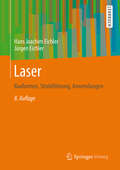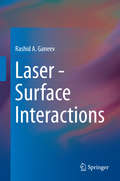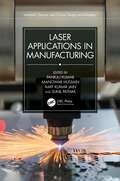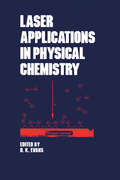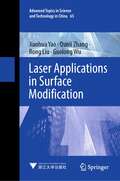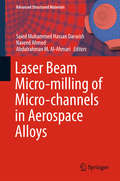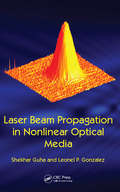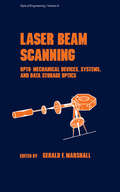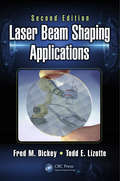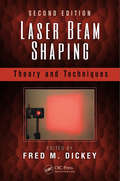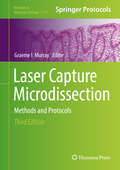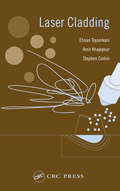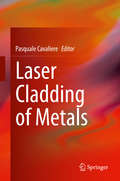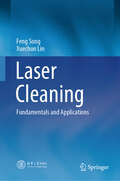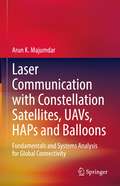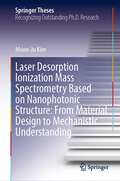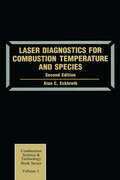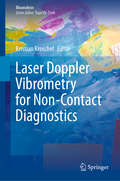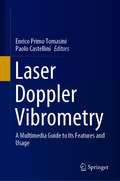- Table View
- List View
Las frutas que comemos
by Gail GibbonsThis beloved primer on our favorite fruits is now available in a newly translated Spanish edition!Berries, apples, melons, and grapes; oranges, grapefruits, bananas -- yum! This Spanish translation of Gail Gibbons&’ most scrumptious picture book, derived from the newly updated edition, offers young Spanish-language readers an inviting, information-packed cornucopia of facts about our favorite fruits. The clear, simple Spanish text presents fruit facts galore: the parts of fruits, where and how they grow, harvesting, processing, where to buy them, and how to enjoy them as part of a healthy diet. Illuminating illustrations and diagrams in Gail Gibbons&’ signature style accompany this accessible and engaging picture book in Spanish.
Las guerras del agua. Privatización, contaminación y lucro
by Vandana Shivasociedad para analizar la histórica erosión de los derechos de acceso al agua por parte de las comunidades humanas. Al analizar el comercio internacional del agua, incluyendo su embalsamiento y extracción, así como la acuicultura, Shiva pone al descubierto la destrucción de la tierra y la pérdida de derechos de los pobres del planeta, a medida que se les niega el acceso a un invaluable bien común. Vandana Shiva revela cómo muchos de los más importantes conflictos actuales a menudo enmascarados como guerras étnicas o religiosas, como el conflicto israelí-palestino, son de hecho disputas por recursos naturales escasos y necesarios. Las guerras del agua resalta la función espiritual y tradicional que el agua ha tenido en comunidades históricas, y alerta acerca de la privatización que amenaza culturas y formas de vida universales. Vandana Shiva es una de las pensadoras más dinámicas y provocadoras del mundo en temas relacionados con el medio ambiente, con los derechos de la mujer y con cuestiones internacionales. Física, ecologista y activista, en 1993 fue distinguida con el Right Livelihood Award, el Premio Nobel alternativo. Es directora de la Fundación para la Investigación de las Ciencias, la Tecnología y la Política de Recursos Naturales.
Laser
by Jürgen Eichler Hans Joachim EichlerDiese grundlegende Einf#65533;hrung in die Physik und Technik der Laser informiert #65533;ber - Funktion, Bauformen und Emissionseigenschaften der Laser, - Lasertypen, optische Komponenten und Strahlf#65533;hrung, - Anwendungen in Materialbearbeitung, Medizin und Messtechnik. Die 8. Auflage dieses etablierten Lehrbuchs ber#65533;cksichtigt neueste Entwicklungen: Hochleistungsdioden- und Festk#65533;rperlaser f#65533;r ultraviolette, sichtbare und infrarote Strahlung, Faserlaser zur Erzeugung ultrakurzer Lichtimpulse und R#65533;ntgenstrahlung aus Freie-Elektronen-Lasern, sowie Anwendungen in der Laserchirurgie, medizinischen Diagnostik und Biophotonik.
Laser - Surface Interactions
by Rashid A. GaneevThis book is about the interaction of laser radiation with various surfaces at variable parameters of radiation. As a basic principle of classification we chose the energetic or intensity level of interaction of laser radiation with the surfaces. These two characteristics of laser radiation are the most important parameters defining entire spectrum of the processes occurring on the surfaces during interaction with electromagnetic waves. This is a first book containing a whole spectrum of the laser-surface interactions distinguished by the ranges of used laser intensity. It combines the surface response starting from extremely weak laser intensities (~1 W cm-2) up to the relativistic intensities (~1020 W cm-2 and higher). The book provides the basic information about lasers and acquaints the reader with both common applications of laser-surface interactions (laser-related printers, scanners, barcode readers, discs, material processing, military, holography, medicine, etc) and unusual uses of the processes on the surfaces under the action of lasers (art conservation, rangefinders and velocimeters, space and earth explorations, surface engineering and ablation, and others). The scientific applications of laser-surfaces interactions (surface optical nonlinearities, surface enhanced Raman spectroscopy, surface nanostructuring, nanoripples and clusters formation, X-ray lasers and harmonic generation from the surfaces) are discussed from the point of view of the close relations between the properties of surface and matter, which is a cornerstone of most of studies of materials. The novelty of the approach developed in Laser - Surface Interactions is related with the interconnection of scientific studies with numerous applications of the laser-surface interactions separated in different chapters by the ranges of laser intensities. We present most recent achievements in this field. The book provides valuable information for different ranges of reader's preparedness to the laser-related topics (from unprepared readers, to students, engineers and researchers, professionals and academics).
Laser Additive Manufacturing of High-Performance Materials
by Dongdong GuThis book entitled "Laser Additive Manufacturing of High-Performance Materials" covers the specific aspects of laser additive manufacturing of high-performance new materials components based on an unconventional materials incremental manufacturing philosophy, in terms of materials design and preparation, process control and optimization and theories of physical and chemical metallurgy. This book describes the capabilities and characteristics of the development of new metallic materials components by laser additive manufacturing process, including nanostructured materials, in situ composite materials, particle reinforced metal matrix composites, etc. The topics presented in this book, similar as laser additive manufacturing technology itself, show a significant interdisciplinary feature, integrating laser technology, materials science, metallurgical engineering and mechanical engineering. This is a book for researchers, students, practicing engineers and manufacturing industry professionals interested in laser additive manufacturing and laser materials processing. Dongdong Gu is a Professor at College of Materials Science and Technology, Nanjing University of Aeronautics and Astronautics (NUAA), PR China.
Laser Applications in Manufacturing (Materials, Devices, and Circuits)
by Pankaj Kumar Sunil Pathak Manowar Hussain Amit Kumar JainThis book introduces the emerging areas of laser-based manufacturing such as additive manufacturing (AM) of metal matrix composites (MMCs), joining of hard-to-weld superalloys, damage-free machining of fiber-reinforced composites, surface properties enhancement using cladding techniques, and modeling and simulation of laser beam manufacturing techniques. Laser Applications in Manufacturing provides a quick guide for researchers and academicians to recent advancements in the development of powder-based MMCs manufactured using AM technology. This book: shows recent developments in functionally graded sheets or laminates and fabrication of fiber-reinforced composite using sheet lamination printing lists recent developments in the joining of dissimilar materials in diverse applications such as hybrid structures and lightweight components for increased performance and functionality includes many recent developments in machining carbon fiber, glass fiber, and natural fiber composite laminates for investigations of delamination and surface quality characteristics showcases different aspects of surface alloying of miniature components, hard and soft composite coating for various applications. Laser Applications in Manufacturing is recommended for researchers working on fabrication of numerous new and novel materials. The book serves as a resource for scientists and engineers working in laser-based manufacturing techniques who want to learn about the most up-to-date research.
Laser Applications in Physical Chemistry
by D.K. EvansThis book provides an introduction on applications of lasers in Chemistry. It describes laser as a tool for chemistry, the consideration involved in describing a laser beam and what happens to beam as it is propagated through a gas. The book is useful for graduates and advanced undergraduates.
Laser Applications in Surface Modification (Advanced Topics in Science and Technology in China #65)
by Jianhua Yao Rong Liu Qunli Zhang Guolong WuThis book introduces the applications of laser in surface modification, such as laser cladding of Stellite alloys and metal-ceramic composites. Besides, nanomaterials including carbon nanotubes and Al2O3 nanoparticles are brought into the laser processing, to form high-temperature resistance, chemical stability, and wear- and oxidation-resistant composite coatings. The readers will get more knowledge about the basic principle and application of laser cladding and laser surface hardening technologies, and gain a deep insight into the process and characteristics of the nanomaterial-assisted laser surface enhancement. It provides references for the researchers, engineers, and students in the fields of mechanical engineering, laser processing, and material engineering.
Laser Beam Micro-milling of Micro-channels in Aerospace Alloys
by Saied Muhammed Hassan Darwish Naveed Ahmed Abdulrahman M. Al-AhmariThis volume is greatly helpful to micro-machining and laser engineers as it offers obliging guidelines about the micro-channel fabrications through Nd:YAG laser beam micro-milling. The book also demonstrates how the laser beam micro-milling behaves when operating under wet conditions (under water), and explores what are the pros and cons of this hybrid technique. From the predictive mathematical models, the readers can easily estimate the resulting micro-channel size against the desired laser parametric combinations. The book considers micro-channels in three highly important research materials commonly used in aerospace industry: titanium alloy Ti-6Al-4V, nickel alloy Inconel 718 and aluminum alloy AA 2024. Therefore, the book is highly practicable in the fields of micro-channel heat exchangers, micro-channel aerospace turbine blades, micro-channel heat pipes, micro-coolers and micro-channel pulsating heat plates. These are frequently used in various industries such as aerospace, automotive, biomedical and micro-electronics.
Laser Beam Propagation in Nonlinear Optical Media
by Shekhar Guha and Leonel P. Gonzalez"This is very unique and promises to be an extremely useful guide to a host of workers in the field. They have given a generalized presentation likely to cover most if not all situations to be encountered in the laboratory, yet also highlight several specific examples that clearly illustrate the methods. They have provided an admirable contribution to the community. If someone makes their living by designing lasers, optical parametric oscillators or other devices employing nonlinear crystals, or designing experiments incorporating laser beam propagation through linear or nonlinear media, then this book will be a welcome addition to their bookshelf."—Richard Sutherland, Mount Vernon Nazarene University, Ohio, USA Laser Beam Propagation in Nonlinear Optical Media provides a collection of expressions, equations, formulas, and derivations used in calculating laser beam propagation through linear and nonlinear media which are useful for predicting experimental results. The authors address light propagation in anisotropic media, oscillation directions of the electric field and displacement vectors, the walk-off angles between the Poynting and propagation vectors, and effective values of the d coefficient for biaxial, uniaxial, and isotropic crystals. They delve into solutions of the coupled three wave mixing equations for various nonlinear optical processes, including quasi-phase matching and optical parametric oscillation, and discuss focusing effects and numerical techniques used for beam propagation analysis in nonlinear media, and phase retrieval technique. The book also includes examples of MATLAB and FORTRAN computer programs for numerical evaluations. An ideal resource for students taking graduate level courses in nonlinear optics, Laser Beam Propagation in Nonlinear Optical Media can also be used as a reference for practicing professionals.
Laser Beam Propagation: Generation and Propagation of Customized Light
by Andrew ForbesHow do laser beams propagate? Innovative discoveries involving laser beams and their propagation properties are at the heart of Laser Beam Propagation: Generation and Propagation of Customized Light. This book captures the essence of laser beam propagation. Divided into three parts, it explores the fundamentals of how laser beams propagate, and pro
Laser Beam Scanning: Opto-Mechanical Devices, Systems, and Data Storage Optics (Optical Science And Engineering Ser. #8)
by MarshallWritten in an easy-to-read style, this comprehensive guide examines the currentknowledge on opto-mechanical laser beam scanning technology.Combining theoretical and practical aspects, Laser Beam Scanning discusses theapplications, performance, and design of holographic, polygonal, galvanometric, andresonant scanning systems.Bringing together the expertise of leading international authorities, this invaluable sourceprovides unique coverage on gas bearings for rotating scanning devices and windageassociated with polygonal scanners. This work also includes authoritative information onGaussian beam diameters and optical design of components and systems relating tooptical disk data storage.Containing time-saving chapter introductions and summaries, numerous illustrations andtables, useful definitions, and up-to-date references, this handy, on-the-job reference aidsoptical engineers and designers, electronic, electrical, and laser engineers; physicists; andgraduate-level students in optical engineering courses to apply laser beam scanning tonew designs successfully.
Laser Beam Shaping Applications (Optical Science and Engineering #1)
by Fred M. Dickey and Todd E. LizotteThis new edition details the important features of beam shaping and exposes the subtleties of the theory and techniques that are best demonstrated through proven applications. New chapters cover illumination light shaping in optical lithography; optical micro-manipulation of live mammalian cells through trapping, sorting, and transfection; and laser beam shaping through fiber optic beam delivery. The book discusses applications in lithography, laser printing, optical data storage, stable isotope separation, and spatially dispersive lasers. It also provides a history of the field and includes extensive references.
Laser Beam Shaping: Theory and Techniques, Second Edition (Proceedings Of Spie Ser.)
by Fred M. DickeyLaser Beam Shaping: Theory and Techniques addresses the theory and practice of every important technique for lossless beam shaping. Complete with experimental results as well as guidance on when beam shaping is practical and when each technique is appropriate, the Second Edition is updated to reflect significant developments in the field. This authoritative text: Features new chapters on axicon light ring generation systems, laser-beam-splitting (fan-out) gratings, vortex beams, and microlens diffusers Describes the latest advances in beam profile measurement technology and laser beam shaping using diffractive diffusers Contains new material on wavelength dependence, channel integrators, geometrical optics, and optical software Laser Beam Shaping: Theory and Techniques, Second Edition not only provides a working understanding of the fundamentals, but also offers insight into the potential application of laser-beam-profile shaping in laser system design.
Laser Capture Microdissection
by Graeme I. MurrayLaser microdissection techniques have revolutionized the ability of researchers in general, and pathologists in particular, to carry out molecular analysis on specific types of normal and diseased cells and to fully utilize the power of current molecular technologies including PCR, microarrays, and proteomics. In second edition of Laser Capture Microdissection: Methods and Protocols, experts in the field provide the reader with practical advice on how to carry out tissue-based laser microdissection successfully in their own laboratory using the different laser microdissection systems that are available and to apply a wide range of molecular technologies. The individual chapters encompass detailed descriptions of the individual laser based micro-dissection systems. The downstream applications of the laser microdissected tissue described in the book include PCR in its many different forms as well as gene expression analysis including application to microarrays and proteomics. Written in the highly successful Methods in Molecular Biology(tm) series format, chapters include introductions to their respective topics, lists of the necessary materials and reagents, step-by-step, readily reproducible laboratory protocols, and tips on troubleshooting and avoiding known pitfalls. Authoritative and cutting-edge, Laser Capture Microdissection: Methods and Protocols, Second Edition is an ideal resource for researchers striving to move forward our understanding of normal physiology and pathology.
Laser Cladding
by Amir Khajepour Ehsan Toyserkani Stephen F. CorbinLaser Cladding reviews the techniques and equipment, process modeling and control, and the physical metallurgy of alloying and solidification during laser cladding. The authors clarify the interconnections laser cladding has with CAD/CAM design; automation and robotics; sensors, feedback, and control; physics material science, heat transfer, fluid dynamics, and powder metallurgy. As the first book entirely dedicated to the topic, it also offers a history of its development and a guide to applications and market opportunities. The book also compiles valuable information illustrated with real case studies based on the authors' experience.
Laser Cladding of Metals
by Pasquale CavaliereLaser cladding is an additive manufacturing technology capable of producing coatings due to the surface fusion of metals. The selected powder is fed into a focused laser beam to be melted and deposited as coating. This allows to apply material in a selected way onto those required sections of complex components. The process main properties are the production of a perfect metallurgically bonded and fully dense coatings; the minimal heat affected zone and low dilution between the substrate and filler material resulting in functional coatings that perform at reduced thickness, so fewer layers are applied; fine, homogeneous microstructure resulting from the rapid solidification rate that promotes wear resistance of carbide coatings; near net-shape weld build-up requires little finishing effort; extended weldability of sensitive materials like carbon-rich steels or nickel-based superalloys that are difficult or even impossible to weld using conventional welding processes; post-weld heat treatment is often eliminated as the small heat affected zone minimizes component stress; excellent process stability and reproducibility because it is numerical controlled welding process. The typical applications are the dimensional restoration; the wear and corrosion protection; additive manufacturing. The wide range of materials that can be deposited and its suitability for treating small areas make laser cladding particularly appropriate to tailor surface properties to local service requirements and it opens up a new perspective for surface engineered materials. The main key aspect to be scientifically and technologically explored are the type of laser; the powders properties; the processing parameters; the consequent microstructural and mechanical properties of the processed material; the capability of fabrication of prototypes to rapid tooling and rapid manufacturing.Distills critical concepts, methods, and applications from leading full-length chapters, along with the authors’s own deep understanding of the material taught, into a concise yet rigorous graduate and advanced undergraduate text;Reinforces concepts covered with detailed solutions to illuminating and challenging industrial applications;Discusses current and future applications of laser cladding in additive manufacturing.
Laser Cleaning: Fundamentals and Applications
by Feng Song Xuechun LinThis book highlights a comprehensive summary of the latest advances in research and applications of laser cleaning. As an innovative way of surface treatment, laser cleaning has received increasing global attention in today's environmentally conscious world. Laser cleaning has gone through a long history from theories to technological developments, and to a wide spectrum of applications. The book first presents the fundamental physics of laser cleaning and demonstrates how the theories have guided the innovation of technology and applications. Following that, the new and most used equipment for laser cleaning has been introduced. Applications in electrics, paint removal, rust removal, the mold industry, cultural heritage protection, and other fields are summarized with plenty of examples and discussions. The book is a valuable reference in laser cleaning for researchers who seek inspiration for their research, engineers who need specific information to guide their work, and students who must learn systematically with working examples.
Laser Communication with Constellation Satellites, UAVs, HAPs and Balloons: Fundamentals and Systems Analysis for Global Connectivity
by Arun K. MajumdarThis book presents posits a solution to the current limitations in global connectivity by introducing a global laser/optical communication system using constellation satellites, UAVs, HAPs and Balloons. The author outlines how this will help to satisfy the tremendous increasing demand for data exchange and information between end-users worldwide including in remote locations. The book provides both fundamentals and the advanced technology development in establishing worldwide communication and global connectivity using, (I) All-Optical technology, and (ii) Laser/Optical Communication Constellation Satellites (of different types, sizes and at different orbits), UAVs, HAPs (High Altitude Platforms) and Balloons. The book discusses step-by-step methods to develop a satellite backbone in order to interconnect a number of ground nodes clustered within a few SD-WAN (software-defined networking) in a wide area network (WAN) around the world in order to provide a fully-meshed communication network. This book pertains to anyone in optical communications, telecommunications, and system engineers, as well as technical managers in the aerospace industry and the graduate students, and researchers in academia and research laboratory.Proposed a solution to the limitations in global connectivity through a global laser/optical communication system using constellation satellites, UAVs, HAPs and Balloons;Provides both fundamentals and the advanced technology development in establishing global communication connectivity using optical technology and communication constellation satellites;Includes in-depth coverage of the basics of laser/optical communication constellation satellites.
Laser Desorption Ionization Mass Spectrometry Based on Nanophotonic Structure: From Material Design to Mechanistic Understanding (Springer Theses)
by Moon-Ju KimThis book presents innovative laser desorption ionization (LDI)-active nanophotonic structures for addressing the challenges that matrix-assisted laser desorption ionization mass spectrometry (MALDI-MS) is currently facing and for enhancing LDI efficiency. It presents a variety of cutting-edge nanophotonic structures to satisfy the mass-analytical needs of sensitivity, reproducibility, and quantification. As opposed to the commercialized, conventional organic matrix used in MALDI-MS, these nanostructures are validated to be highly effective in detecting small metabolites and drugs, highlighting their considerable potential in the mass spectrometry field. It also systematically elucidates fundamental LDI processes in terms of the photo-thermal, electronic, and structural characteristics of nanophotonic structures, offering mechanistic knowledge of LDI-MS. Even though LDI-MS performance is heavily influenced by a number of nanostructure parameters, relatively little is known about the LDI processes associated with those characteristics. An in-depth understanding of nanostructure characteristics and LDI mechanisms thus paves the way for more effective, rational design and development of nanostructures with improved LDI capabilities. Further, with a focus on multiple cascades in nanostructure functions in response to laser pulse stimuli, this book provides detailed, step-by-step procedures to design and construct a nanophotonic, LDI-active platform, which may serve as a roadmap for graduate students in the field of mass spectrometry. Readers, including graduate students, researchers, and experts working in the related areas of mass spectrometry, nanophotonics, and material science and material engineering, will find a wealth of useful information in this book.
Laser Diagnostics for Combustion Temperature and Species
by Alan C. EckbrethThis book examines the variety of potential laser diagnostic techniques and presents a considerable theoretical foundation elucidating physics relevant to the laser diagnostics. It explains the Raman-based approaches for major species and temperature measurements.
Laser Diode Beam Basics, Manipulations and Characterizations
by Haiyin SunMany optical design technical books are available for many years which mainly deal with image optics design based on geometric optics and using sequential raytracing technique. Some books slightly touched laser beam manipulation optics design. On the other hand many books on laser diodes have been published that extensively deal with laser diode physics with little touching on laser diode beam manipulations and characterizations. There are some internet resources dealing with laser diode beams. However, these internet resources have not covered enough materials with enough details on laser diode beam manipulations and characterizations. A technical book concentrated on laser diode beam manipulations and characterizations can fit in to the open and provide useful information to laser diode users. Laser Diode Beam Basics, Manipulations and Characterizations is concentrated on the very practical side of the subject, it only discusses the basic physics and mathematics that are necessary for the readers in order to understand the subject. This book is intended to provide a practical guidance and reference to those scientists and engineers who are still new to laser diode applications, and to those undergraduate and graduate students who are studying lasers and optics. Readers are expected to be able to fast and easily find the most practical and useful information about laser diodes in this book without the need of searching through a sea of information.
Laser Diodes and Their Applications to Communications and Information Processing
by Takahiro NumaiIn order to develop excellent photonic devices, we have to fully understand the physics behind operations of photonic devices. This book thoroughly teaches the fundamental physics currently applied to the development of photonics devices such as energy bands of semiconductors, optical transitions, optical waveguides, and semiconductor junctions. The book also reviews the characteristics of laser diodes, optical filters, and optical functional devices, which have been developed based on the above physics. These photonic devices have been demonstrated in system applications, and several experimental results are described.
Laser Doppler Vibrometry for Non-Contact Diagnostics (Bioanalysis #9)
by Kristian KroschelThis book presents recent outcomes of the collaborative “Tricorder” project, which brings together partners from industry, research institutes and hospitals to deliver an easy contactless alternative for electrocardiograms (ECG).Featuring contributions investigating the possible applications of laser Doppler vibrometry (LDV) signals for the remote measurement of vital parameters of the heart, the book provides insights into the vision and the history of the "Tricorder" project and the basic differences between the vibrocardiograms and electrocardiograms. It also discusses topics such as signal processing, heartbeat measurement techniques, respiration frequency and oxygen saturation determination, with a particular focus on the diagnostic value of the method presented, e.g., diagnosis of atrial fibrillation and estimation of the oxygen saturation in premature infants. Further, the authors review the advantages and drawbacks of the new method and the specific fields of application.This book will appeal to researchers and industry leaders interested in laser remote sensing for medical applications as well as medical professionals curious about new healthcare technologies.
Laser Doppler Vibrometry: A Multimedia Guide to its Features and Usage
by Paolo Castellini Enrico Primo TomasiniThis book is a continuous learning tool for experienced technical staff facing laser vibrometry technology for the first time. The book covers both theoretical aspects and practical applications of laser Doppler vibrometry, and is accompanied by a multimedia presentation that allows the audience to browse the content and come as close as possible to performing real experiments. After a brief introduction, Chapter 2 presents supporting theory, providing general information on light sources, light scattering and interference for a better understanding of the rest of the book. Chapter 3 examines the theory of laser vibrometers, explaining interferometers from an optical perspective and in terms of the related electronics. It also addresses options like tracking filters and different signal demodulation strategies, since these have a significant impact on the practical use of vibrometers. Chapter 4 explores the configurations that are encountered in today’s instrumentation, with a focus on providing practical suggestions on the use of laser vibrometers. Lastly, Chapter 5 investigates metrology for vibration and shock measurements using laser interferometry, and analyses the uncertainty of laser vibrometers in depth.


